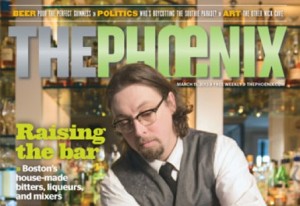Fuse Commentary: What Does the End of Newspapers Mean for the Arts in Boston?

The final issue of The Boston Phoenix — one more nail in the coffin of professional arts coverage in the city.
By Shujie Leng.
The changes in Boston’s media landscape do not bode well for substantial coverage of the arts. The end and/or diminishment of newspapers and magazines has meant the vaporizing of serious professional reporting and reviews. Worse, the migration of journalism online has not inspired many attempts to generate meaningful conversation about culture.
We decided to ask artists, educators, and members of cultural organizations and institutions to speculate what this media drought will mean for the future of the arts in Boston. Here are the reactions—from the anxious to the unconcerned. We will add more as they come in. Please feel free to add your own comments, opinions, and arguments. We want to hear from you.
Questions:
The Boston Phoenix is no longer around. The Boston Globe is for sale. With professional arts and culture coverage shrinking, what do you think will be the impact on the health of Boston’s arts institutions and artists? If this trend continues, what do you seeing happening in the future? From both an editorial and advertising perspective, what have you lost?
Stan Trecker
Stan Trecker is the dean of The Art Institute of Boston at Lesley University (AIB). He has over 30 years of experience as a senior leader in higher education and arts administration. He was the executive director of The Photographic Resource Center in Boston.
Clay Fernald
Largely, the biggest difference I see is that, while the Boston Globe is an institution, the biggest loss for the city’s arts and music community was when the Boston Phoenix shut down.
News is broken via Twitter, Facebook, and blogs. Most strong newspapers, (including The Globe, Phoenix, and DigBoston) have more of a presence and personality online than they do in their print version. The arts and music covered by the Phoenix writers week after week couldn’t be contained in an issue of the glossy magazine it had become.
Sure, my parents would pick up a Phoenix to see what was happening at our club every week, but were the advertising dollars being spent there worth it to bring people to the shows? We sustained and curated a deprecated strip ad for years, long after this was a vital way we got in touch with our fans.
Lumped in with an old-media view of the world is radio advertising. We also curated and produced weekly ad spots well after WFNX was sold and the station was reduced to an online streaming property.
We rolled along this way with the Boston Phoenix because they are our friends behind the keyboard there, behind the mic console, and the Phoenix and the Middle East have a pretty similar history. Independent media, the same age as our independent venue.
The Globe is a bit more detached from the scene. Of course we have great friends over there as well in editorial. Its RadioBDC is an interesting model for internet radio. But the paper runs on a scale that we just can’t reach up and touch. We are entirely grateful to see our shows covered by the Globe, but mostly this is on Boston.com, not in the paper itself. The newsprint readers are not our target audience.
When it comes to print advertising, the big corporations have the budgets to sustain glossy magazines and full pages in newsprint papers. That’s an easily justifiable spend for those corporations. What was happening as a trend in the last five years or so was that the rates for the ads were increasing, and our ad budget stayed the same. We were wondering what we were paying for, in the long run, given the question of how many eyeballs our ad.
We at the Middle East rely on smart editorial coverage of the cool, new, up and coming acts coming to town. It is the music writers who discover them first. Luckily for us, it is just as easy to tweet and share an article with our engaged fans via a blog post on someone’s personal blog as it is to do the same with a newspaper’s Twitter name attached to it.
Clay Fernald is the general manager of the Middle East Nightclub in Cambridge, MA and a publicist. He contributes to DigBoston in a weekly column, Earth Prime Time, dedicated to the coverage of comic books and is part of LeaguePodcast, Boston’s pop culture and comic book podcast.
Dayla Arabella Santurri
It’s disappointing to me, that a city with such a rich legacy of live arts, that produces so many wonderful artists and arts organizations in its our own backyard, doesn’t collectively fight harder to keep arts coverage alive and well – before they’re halfway out the door.
Creative partnerships between venues, arts & community organizations, media outlets, commercial partners, the public, individual artists, educators, parents and everyone and anyone that has a stake in a vibrant arts community must be formed to demand AND pay for comprehensive arts coverage.
Moving the next generation away from their small screen world of video games and online networks and the Millennials, Gen Xers & Baby Boomers away from their big screen television sets and into our theatres, clubs, concert halls and galleries is a tall order. We’ll need all hands on deck to get the job done.
Dayla Arabella Santurri is the Co-Founder and Executive Vice President of Boston Women in Media & Entertainment. She has over 18 years of experience in event planning, concert production, media relations and marketing strategy.
Richard Bouchard
As a promoter and a booker of shows, I want as many places as I can to send information, to talk about why the show is worth covering. The Boston Phoenix was one of the better places to send material to, just because it has been there so long and had such big reputation.
Frankly, because I promote shows, I knew some music editors at Phoenix, like Michael Marotta. When you send him some information about a new band, Michael would just right away [say] he got it. He might not write about it, but at least you know he got it. Personally, that was a big deal. I can do the same thing to the music editor at Boston Herald, but it was definitely easier to get in touch with people at the Phoenix, once they know who I was and what I was about. So, for me it’s sad that they are gone.
Right now, there’s a void there, where The Phoenix was. Things will pop up to fill it, but it’s going to take a while. It’s going to take a lot of work (for DigBoston etc.) to replace the Phoenix. I guess there’ll be more blogs popping up, small, localized blogs. Audiences create a community. There might be less stuff about the arts in print, but people who are looking for information will find it out on their own. There’s a healthy music community in Boston, but it’s not huge, not as big as the readership of the Boston Phoenix. It would be nice to build a community of writers, bloggers, etc, that reach to people outside music circles.
What losing something like Phoenix means that people that aren’t necessarily looking for good music won’t come cross information about it. It’s an incentive when a journalist you trust tells you to listen to something. They think you might like it and the reader is willing to give it a chance. You lose that kind of invitation when media like the Phoenix goes under.
For music bands, they lose an important outlet for promotion, because thousands of people pick up Phoenix. There will be the same amount of bands here, but having a song played on WFNX (the Phoenix’s radio station) was a big deal. Now it’s gone. It’s a blow to the bands.
I don’t advertise on the Phoenix. They did give my blogs some mentions on occasions. I never bought ads. But there are small local places that can’t afford ads in the Herald. There are smaller outlets for smaller businesses, and the smaller places were likely to target the Phoenix than the Herald.
The Boston Phoenix had the third highest circulation of weekly magazines in the U.S. There other two are LA Weekly and the Village Voice. So it’s a loss for everyone, not just in Boston. It’s less likely those writers, photographers and editors at Phoenix are going to have some places for their writing, unless they start something, such as a blog, on their own.
Having something in print is important. When you walk into T, you can grab it from the box and read it. Hopefully, in a short term, some outlets will pick up editors from the Phoenix. Arts coverage will go to blogs. When a community of artists is created, the print media can’t ignore it. Coverage will go online and then come back to print, in some form.
Richard Bouchard is a local musical show booker at T.T. the Bear’s Place in Cambridge and the co-host of The Scrunity podcast, which discusses music, media and art. He was the former editor-in-chief of a rock group blog, Boston Band Crush.
Darren Evans
Anyone can see that the arts media landscape in Boston has shifted dramatically in the past decade. Arts coverage in all the major papers has diminished – even before the Phoenix closed up shop, its coverage of theatre, for example, had been whittled away to nearly nothing – while at the same time online publications have sprouted up left and right. In some ways, there may be more outlets for coverage now than there were in the past. The question is whether those outlets are reaching people. Are people reading Big, Red and Shiny as much as The Globe? Do independent theatre reviewers reach audiences the way the Phoenix once did? Also, the rise of online arts coverage opens the door for more direct conversation and commentary from readers (more so than, say, a letter to the editor). Are people taking advantage of these interactive opportunities?
I don’t think anyone has answers to any of those questions, as the “rules” are changing rapidly – it feels a bit like the Wild West right now. But just as there are major challenges, there seem to be many opportunities of which savvy marketers can take advantage.
Darren Evans is the Director of Programs at Boston Center for the Arts.
Tagged: Clay Fernald, Darren Evans, Dayla Arabella Santurri, Richard Bouchard




